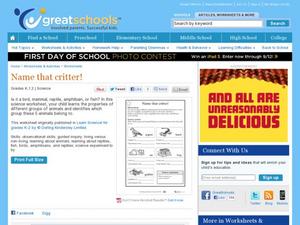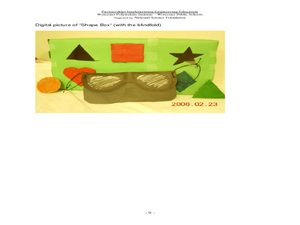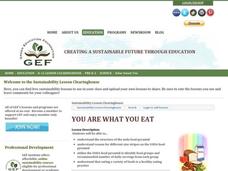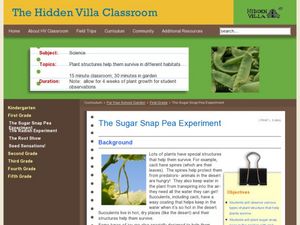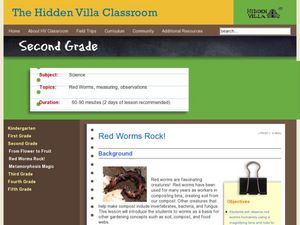BBC
Ourselves
Young biologists identify parts of the body, sort humans from other animals, and list the difference they see. Learners are split up into groups of three, and each group must find pictures in magazines of humans and other animals. They...
BBC
Sound and Hearing
First and second graders recognize that sound is generated in a variety of ways, and that it comes from many different sources. They explore tone and volume, realizing that there are different ways to describe sound. Some musical...
Curated OER
Name That Critter
Young learners classify five different animals into their proper category. The animals pictured are a pigeon, a lizard, a cat, a frog, and a goldfish. Pupils are also asked to tell why they know it's a certain kind of animal. An...
Curated OER
Does It Move On It's Own?
Young scientists look at drawings of six animals, then match up a word that describes how they move. The words are: hop, crawl, swim, fly, run, and jump. They also answer two additional questions about the animals and how they move. A...
Curated OER
Human Parts
Very young learners who are studying the human body will use this worksheet to identify certain body parts. A cartoon drawing of a boy is shown, and learners must draw lines matching up words such as arm, tummy, foot, and toes to the...
Curated OER
Being Alive
Young biologists use a activity to fill in the blanks of five sentences. Each one needs a word from a word band at the top of the resource. All of the sentences are about things that are alive, and how we know they are alive. The words...
Curated OER
Penguins Around the World
Students investigate penguins. In this Science lesson, students compare and contrast penguins to flying birds. Students use a Venn diagram to illustrate the differences and similarities of penguins and flying birds.
Curated OER
Cat Facts
Kids love cats! Here is a instructional activity that invites youngsters to do some research on the critters. They must answer questions such as: "How many different kinds of cats are there?" "Why did Egyptians worship cats?" and, "How...
Curated OER
Eyes On Me
Students investigate the human eye. In this biology lesson, students read the book Look At Your Eyes and locate the various parts of their eye. Students play the game "I Spy."
Curated OER
Your Five Senses
Young scholars identify the five senses. In this biology lesson, students participate in an experiment and use their five senses to identify various substances.
Curated OER
Temperature
Young biologists discover that plants and animals have protective parts that help them to survive during periods of harsh conditions. After a meaningful class discussion, pupils complete three worksheets by working in pairs to reinforce...
Curated OER
Root Structures
Plant roots are the focus here. Pupils discover that some plants actually store food in their roots, that roots provide water for plants, and that gravity and sunlight have an effect on plants. This terrific, six-page plan has two...
Curated OER
The Plant
Here is a good, basic, and solid lesson plan on the parts of a plant. Young biologists learn about the parts of a plant, and what each one does. Additionally, learners look at the parts of plants that are used by people and determine...
Curated OER
Which Plants Grew Best?
This presentation gives a visual account of a class's experiment growing sprouts under different conditions. There are three containers with the same soil and the same seeds. One of the containers got water, but no light. One got light,...
Curated OER
Word Search: Common Seashore Plants
I really like these colorful word searches put out by The Waterford Press. Learners view 18 beautiful and accurate drawings of common seashore plants, and then must find them in a word search. An answer key is provided.
Curated OER
Recognizing the Importance of Sight
Students discover the true value of their senses. In this sight lesson, students discover the difficulty of life without sight by performing everyday activities without the help of their eyes. The students examine their results and the...
Curated OER
You Are What You Eat
Students identify healthy food choices from the food groups on the USDA food pyramid. In this nutrition and health lesson, students identify and name examples of each food group displayed on the food pyramid. Students cut out healthy...
Curated OER
The Sugar Snap Pea Experiment
Young scholars examine types of plant structure. In this plant biology instructional activity, students observe various types of plants, such as ivy and grapes, and discuss the differences in structure. Additionally, young scholars plant...
Curated OER
Red Worms Rock!
Second graders measure red worms. In this lesson plan, 2nd graders observe and collect data on red worms. Students measure the red worms and create a graph with the data they collect.
Curated OER
Who am I?
A matching activity on some common marine mammals is here for you. In it, 12 animals such as polar bears and seals are found. Each of the animals has a colorful and accurate picture associated with it. The bonus question at the bottom...
Curated OER
Who am I?
Here is a colorful worksheet that has learners identify 16 different kinds of insects. Each insect has an accurate and colorful drawing associated with it. The insect names are at the bottom of the worksheet, and pupils must match up...
Curated OER
Earth's Heavenly Treasures: Hummingbirds
Young ornithologists watch an informative video and use the Internet to gather data about the life, size, habitat, and migration of hummingbirds. The interdisciplinary lesson includes activities that target art, science, math, and...
Curated OER
The Amazing Ant
Students explain that ants are an important element of nature's balance. Ants eat many insects and are food to other animals. They watch a video and conduct hands-on activities that give them an excellent overview of the ants role in...
Curated OER
Where is Shirley the Elephant?
Young animal lovers engage in a lesson that's all about elephants. They access an elephant sanctuary website and read a story about Shirley the elephant. They perform a series of activities based upon that story, and also study about the...




